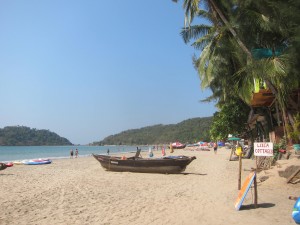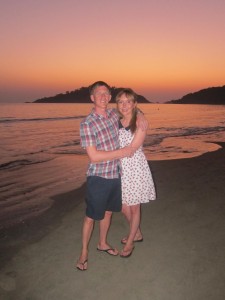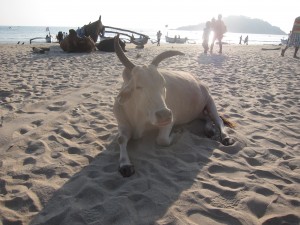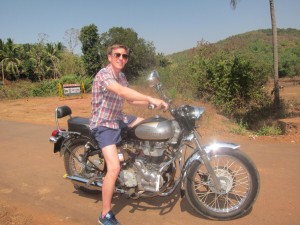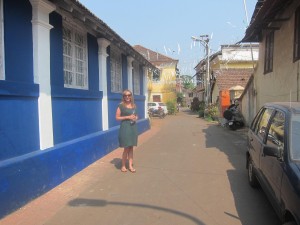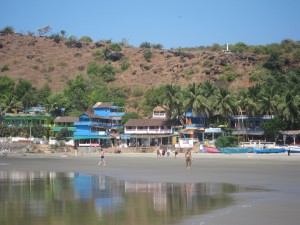The last three weeks have been spent in Goa, the beach holiday capital of India. We took a train from Hampi to Palolem, one of the southernmost beaches in Goa.
Staying in Palolem was a little like floating through a dream. It’s a white, sandy crescent bay tossed at either end with a handful of boulders. A palm-tree grove follows the curve of the beach, part-camouflaging temporary beach-front bars and coco-huts, most of which are dismantled each year during the monsoon and re-assembled. At night the whole bay turns a deep orange and the softly lit bars softly waft music, barely audible over the rolling waves.
Sometimes it felt more like a farm than a beach: beach dogs continuously comb the beach for scraps; cows sunbathe smug and unmolested while their porcine cousins trot about terrified, lest someone should order a Pork Vindaloo from one of the beach side restaurants. Chickens, roosters, crows, frogs, lizards, even the odd monkey join the fighting, howling dogs and the fighting, squealing pigs in a nighttime cacophony so loud that, were it at home, you’d be banging bleary-eyed at next door.
So how do you sleep at night? Why, you get drunk of course.
Goa, in it’s hippy hey-dey, was a place for hippies to come, take drugs, and dance to trance music ’til the sun came up (often naked apparently?). This, it seems, was fine until the Indians started joining in, then it became anathema to Indian conservatism; a place for Indians to come and behave in a decidedly un-Indian way. Laws were passed to curb the reveler’s enthusiasm, one of which was to ban loud music after 10pm. In Palolem they get round this law – brilliantly I feel – by running Silent Discos each night, where they hand out a set of head-phones as you walk in.
The only thing of note we actually did in Palolem was to hire out a 500cc Enfield Bullet (the classic Indian ride, yaar) and set out to find a local beauty spot, Cola Beach, which was 20km outside of town. Anyway, 40km down the road the guy we rented the bike from pulled up in a jeep and shouted “Where are you going?”.
“Cola Beach,” we replied.
“Well what the bloody hell are you doing out here then!?”
We eventually backtracked and found Cola Beach, which was nice enough. But the real treat was gliding on the Enfield along winding forested Indian roads, Amy even enjoyed riding pillion. A funny thing – blind corners are irrelevant to Indians. In fact, it seems preferable to overake on a blind corner or the crest of a hill. So it’s quite common to round a corner and find a bus overtaking a lorry and only an Enfield sized gap to squeeze through.
We came to Palolem for a few nights. Eleven nights we later we left for Panjim.
Panjim is a cute little town whose Portuguese heritage shines through the centuries in it’s pastel painted houses with white-arched window frames, streets named after Catholic saints and its alabaster Catholic churches. This, coupled with the tropical setting, makes it feel like a South American city. We wandered about for a couple of days, took a trip to Old Goa (more of the same really) and then took a ridiculously packed bus – picture school children hanging from the outside – to Arambol, a beach in the North of Goa.
Arambol is like a bigger, dirtier, louder Palolem with no such qualms about playing music late at night. Almost immediately we arrived we fell in with a gang who we got to know so well in the 3 days we were with them that it felt a bit empty when they all left.
Our beach holiday – a holiday from a holiday – is coming to an end. We need to rouse ourselves from our sea-side indolence and get on with the serious business of travelling. We get the sleeper bus to Mumbai on Saturday.

